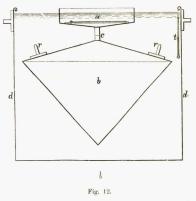
Full resolution (JPEG)
- On this page / på denna sida
- Sidor ...

<< prev. page << föreg. sida << >> nästa sida >> next page >>
Below is the raw OCR text
from the above scanned image.
Do you see an error? Proofread the page now!
Här nedan syns maskintolkade texten från faksimilbilden ovan.
Ser du något fel? Korrekturläs sidan nu!
This page has been proofread at least once.
(diff)
(history)
Denna sida har korrekturlästs minst en gång.
(skillnad)
(historik)
Siile
Kar dd er fyldt. Dette kalder jeg i det følgende ,.det
ydre Vand". Hele Apparatet er gjort af lakeret Jernblik.
Naar Fordunstningsskaalen er tora. er Stetten c og en Del
af Bøjen over Vandet, men naar naar man helder Søvand
water, with which the large cylindrical vessel dd is filled.
This I shall call in the sequel "the outer water". The
whole apparatus is made of japanned sheet-iron. When
the evaporating dish is empty, the stem c and part of the
i
 |
| Fig. 12. |
i Ska alen, synker Bøjen, og Instrumentet er færdigt til
Forsøg, naar det ydre Vand har naaet et Merke paa
Stetten. Vandet staar da i Fordunstningsskaalen en
Centimeter under den øverste Rand. Idet nu Fordunstningen gaar
for sig, bliver Vægten af Vandet i Skaalen a mindre og
mindre, og hele det flydende Apparat løfter sig. For at
finde, hvormeget Vand der er fordunstet, helder man af
en Burette rent Vand i a indtil man ser Merket paa
Stetten i Højde med den omgivende ydre Vandflade. Det
fordunstede Vand, der er rent Vand, er da erstattet fra
Buretten, paa hvilken dets Volum kan aflæses. Da
Overfladen af a er 225 Kvadratcentimeter, vil en Vandmængde
af 22.5 Kubikcentimeter fra Buretten svare til. en
For-dunstningshøjde af 1 Millimeter.
Dersom Fordunstningsskaalen stod frit over det ydre
Vand, omgivet af Luften, vilde dens Vand i Regelen
antage en Temperatur adskilligt højere end den større ydre
Vandmasses i Karret dd, og være underkastet en større
daglig Temperaturvariation end denne. Bøjen vilde ogsaa,
i haardt Vejr, være tilbøjelig til at slænge Vandet ud af
Skaalen. Jeg indrettede mig derfor paa følgende Maade:
Saasnart Instrumentet var paa Merke, blev en Blyring
med to Haandtag rr lagt paa Bøjen. Med denne
Belastning blev hele det flydende Apparat sænket saa meget, at
den indre Vandflade i a stod i samme Højde som den
ydre Vandflade i dd. Den fordunstende Vandflade i a stod
nu omgivet af en ligeledes fordunstende Vandflade af samme
Art, Niveau og Temperatur, analog med en Del af selve
Havfladen. Ved Forsøgets Afslutning tages Blyringen af,
buoy are above water; but on pouring sea-water into the
dish, the buoy sinks, and when the outer water has risen
to a mark on the stem, the instrument is ready for use.
The water in the evaporating dish is then one centimetre
below the upper margin. Now, as evaporation goes on,
the weight of the water in the dish a gradually diminishes,
and the whole of the floating apparatus rises. In order
to find how much water has evaporated, fresh water is
poured from a burette into a till the surface of the outer
water is on a level with the mark on the stem. The
evaporated water, which is fresh water, is then restored
from the graduated burette, on which its volume can be
read off. The surface of a measuring 225 square
centimetres, 22.5 cubic centimetres of water from the burette
represent in height 1 millimetre of evaporated sea-water.
If the evaporating dish were kept free above the
outer water, surrounded by the air, the water it contains
would as a rule take a temperature considerably higher
than that of the greater mass of water in the outer vessel
dd, and be subject to greater variations of temperature.
Moreovei’, in a rough sea the buoy would be more liable
to throw the water out of the dish. I adopted, therefore,
the following arrangement: •— The instrument being
adjusted to the mark, a leaden ring, with two handles rr
was laid upon the buoy. With this ballast, the whole
floating apparatus was so much depressed that the surface
of the inner water in a was on a level with the surface
of the outer water in dd. The evaporating surface of the
water in a was thus surrounded by an evaporating surface
of the same nature, level, and temperature, in every respect
<< prev. page << föreg. sida << >> nästa sida >> next page >>
Project Runeberg, Sun Dec 10 20:01:49 2023
(aronsson)
(diff)
(history)
(download)
<< Previous
Next >>
https://runeberg.org/nordhavexp/2/0148.html




